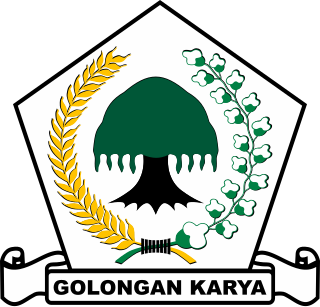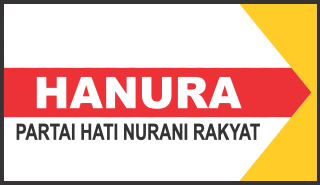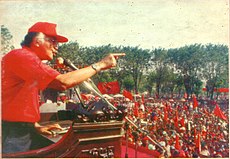
The Indonesian Democratic Party of Struggle is a centre to centre-left secular-nationalist political party in Indonesia. Since 2014, it has been the ruling and largest party in the House of Representatives (DPR), having won 110 seats in the latest election. The party is led by Megawati Sukarnoputri, who served as the president of Indonesia from 2001 to 2004.

The Party of Functional Groups, often known by its abbreviation Golkar, is a centre-right big tent secular nationalist political party in Indonesia. Founded in 1964 as the Joint Secretariat of Functional Groups, it is the oldest extant political party in Indonesia. It first participated in national elections in 1971 as Functional Groups. Since 2009, it has been the second-largest party in the House of Representatives (DPR), having won 102 seats in the latest election.

The United Development Party is an Islam-based political party in Indonesia.

The National Awakening Party, frequently abbreviated to PKB, is an Islam-based political party in Indonesia. It is also the party of the former Vice President of Indonesia, Ma'ruf Amin, who was elected to its Shura Council.

Elections in Indonesia have taken place since 1955 to elect a legislature. At a national level, Indonesian people did not elect a head of state – the president – until 2004. Since then, the president is elected for a five-year term, as are the 580-member People's Representative Council, the 152-seat Regional Representative Council in 2024 general election, in addition to provincial and municipal legislative councils.

The Indonesian Democratic Party was a political party in Indonesia which existed from 1973 to 2003. During the New Order era, the PDI was one of the two state-approved parties, the other being the Islam-based United Development Party (PPP).

Sudharmono, also known by his nickname, Pak Dar, was an Indonesian Army officer and politician, who served as the fifth vice president of Indonesia from 1988 until 1993 under the New Order regime. Previously, he served in several positions in the government and military, including as the Chairman of Golkar, State Secretary of Indonesia, and a lieutenant general in the army.

The National Mandate Party, frequently abbreviated to PAN, is a non-sectarian, religion-based political party in Indonesia.

The Crescent Star Party is a conservative political party in Indonesia based on Islam.

The Indonesian National Party of Marhaenism is a minor political party in Indonesia founded by former Indonesian National Party (PNI) member Supeni in 1995 before changing to the current incarnation in 2002. The party is headed by Sukmawati Sukarnoputri, daughter of national founder Sukarno.
Legislative elections were held in Indonesia on 29 May 1997. There were three simultaneous elections in one because voters were electing members of two levels of regional government as well as the national-level People's Representative Council. This was the last election of President Suharto's New Order regime, which collapsed one year later. Like the preceding New Order elections, it was won outright by the Golkar organization.

Legislative elections were held in Indonesia on 3 July 1971, the first under the New Order regime. There were ten participants; nine political parties and the "functional group" Golkar, which came first with more than 60 percent of the vote, resulting in an absolute majority in the People's Representative Council.

Legislative elections were held in Indonesia on 2 May 1977. They were the third legislative elections since independence, and the second under the New Order regime. There were three participants; the two political parties and functional group Golkar.

Legislative elections were held in Indonesia on 4 May 1982. They were the fourth legislative elections since independence and the third under the New Order regime There were three participants; the two political parties, the United Development Party (PPP), the Indonesian Democratic Party (PDI) and the "functional group" Golkar. As with all elections during the New Order regime, the government-backed Golkar organization won an absolute majority.

Legislative elections were held in Indonesia on 23 April 1987, to elect 400 of the 500 members of the People's Representative Council (DPR), the national legislature. The election was the fifth legislative election in the country since independence and the fourth legislative election under President Suharto's New Order. The election resulted in an outright majority for Golkar, which retained its status as the ruling party of the country.

Early legislative elections were held in Indonesia on 7 June 1999. They were the first elections since the fall of Suharto and end of the New Order, the first free elections in Indonesia since 1955, and the first and only free legislative election held in East Timor during Indonesian provincehood. With the ending of restrictions on political activity following the fall of Suharto, a total of 48 parties contested the 462 seats up for election in the People's Representative Council. A further 38 seats were reserved for members of the armed forces.

The People's Conscience Party, better known by its abbreviation, Hanura, is a political party in Indonesia. It was established following a meeting in Jakarta on 13–14 December 2006 and first headed by former Indonesian National Armed Forces commander Wiranto. The party lost its seats in the People's Representative Council after a poor performance in the 2019 general election.
The 27 July Incident was an attack by Indonesian government forces on the head office of the Indonesian Democratic Party, which was being occupied by supporters of recently ousted party leader Megawati Sukarnoputri. It was followed by two days of riots in Jakarta.

The Indonesian Democratic Union Party,, was a political party founded by Sri Bintang Pamungkas in 1995 and one of the political parties in Indonesia that participated in the 1999 general elections.

























